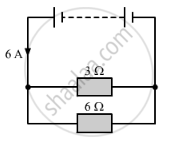Advertisements
Advertisements
Question
In the circuit given below:

(a) What is the combined resistance?
(b) What is the p.d. across the combined resistor?
(c) What is the p.d. across the 3 Ω resistor?
(d) What is the current in the 3 Ω resistor?
(e) What is the current in the 6 Ω resistor?
Solution
(a) The resistors of 6 Ω and 3 Ω are connected in parallel. Therefore, their combined resistance can be calculated as:
1/R = 1/R1 + 1/R2
Here, R1 = 6 Ω ,
R2 = 3 Ω
1/R = (1/6) + (1/3 )
1/R = (1 + 2)/6
R = 6/3
R = 2 Ω
(b) Potential difference, V = IR
The potential difference across the combined resistance,
V = `(6xx2)` V
V = 12 V
(c) The potential difference across the 3 Ω resistor can be calculated as:
V = IR
V =`6xx3`= 18 V
(d) The current across the 3 Ω resistor is:
I = V/R
I = 12/3
I = 4 A
(e) The current across the 6 Ω resistor is:
I = V/R
I = 12/6
I = 2 A
APPEARS IN
RELATED QUESTIONS
Complete the following :-
(b)

What are the advantages of connecting electrical devices in parallel with the battery instead of connecting them in series?
Several electric bulbs designed to be used on a 220 V electric supply line are rated 10 W. How many lamps can be connected in parallel with each other across the two wires of 220 V line if the maximum allowable current is 5 A?
Show how would you join three resistors, each of resistance 9 Ω so that the equivalent resistance of the combination is
1) 13.5
2) 6 Ω
If current flows through two lamps arranged:
(a) in series,
(b) in parallel,
and the filament of one lamps breaks, what happens to the other lamp? Explain your answer.
Five resistors, each 3 Ω, are connected as shown in Fig. Calculate the resistance
- between the points P and Q.
- between the points X and Y.

A uniform wire with a resistance of 27 Ω is divided into three equal pieces and then they are joined in parallel. Find the equivalent resistance of the parallel combination.
The equivalent resistance of a parallel combination of two resistors of 30 Ω and 60 Ω is ______________.

The diagram above is a schematic diagram of a household circuit. The house shown in the above diagram has 5 usable spaces where electrical connections are made. For this house, the mains have a voltage of 220 V and the net current coming from the mains is 22A.
- What is the mode of connection to all the spaces in the house from the mains?
- The spaces 5 and 4 have the same resistance and spaces 3 and 2 have respective resistances of 20Ω and 30Ω. Space 1 has a resistance double that of space 5. What is the net resistance for space 5.
- What is the current in space 3?
- What should be placed between the main connection and the rest of the house’s electrical appliances to save them from accidental high electric current?
